Luiz A.M. (ed.) Superconductor
Подождите немного. Документ загружается.

16
Phase Dynamics of Superconducting
Junctions under Microwave Excitation in
Phase Diffusive Regime
Saxon Liou and Watson Kuo
Department of Physics, National Chung Hsing University, Taichung
Taiwan
1. Introduction
Superconductivity exhibits elegant macroscopic quantum coherence in such a way that the
many-body physics can be understood in a one-body way, described by the
superconducting phase, and its quantum conjugate variable, the charge. When two
superconductors are connected to each other through a tunnel junction, the charge tunneling
can be controlled by the phase difference
φ
, leading to many interesting phenomena. For
decades, because of the robustness of phase coherence in large junctions, a simple classical
approach by modeling the system by a damped pendulum to the problem is successful and
overwhelmed.(Tinkham 1996) However, as the sub-micro fabrication techniques had
emerged in the 1990’s, ultra small junctions were found exhibiting stronger quantum
fluctuations in phase due to charging effect, which cannot be overlooked. For exploring the
novel phenomena in the opposite limit, people have made devices with robust charging
effect. These phenomena can be well understood by treating the charge tunneling as a non-
coherent perturbation to the quantum states described by charge. However, in the case
when the Josephson energy and charging energy are competing, neither approach gives a
satisfactory description. One of the attempts is to include the coherent nature in the charge
tunneling processes by introducing a phase correlation function in time, which quantifies
the robustness of the phase coherence.(Ingold & Nazarov 1991) The correlation function,
which has been studied in many other fields, has a universal relation to the dissipation of
the system, called fluctuation-dissipation theorem. Taken in this sense, dissipation is an
important controlling parameter in the phase coherence robustness. If the environment
impedance of the junction is much smaller than the quantum resistance (for Cooper pairs)
R
Q
=h/4e
2
, the phase fluctuation is strongly damped, leading to pronounced phase
coherence.(Devoret, Esteve et al. 1990) Indeed, why the classical model is so successful? The
pioneer work done by Cadeira and Leggett(Caldeira & Leggett 1983) has pointed out that
the environment impedance plays an important role. Their work stimulated many studies in
dissipation-driven phase transitions in various systems including Josephson
junctions.(Leggett, Chakravarty et al. 1987; Schon & Zaikin 1990)
In this article, we will focus on the responses of Josephson junctions under microwave
irradiation. Theoretically the phenomenon can be explained by the phase dynamics under
an ac driving. In section 2, we will start from a classical picture by considering a Langevin
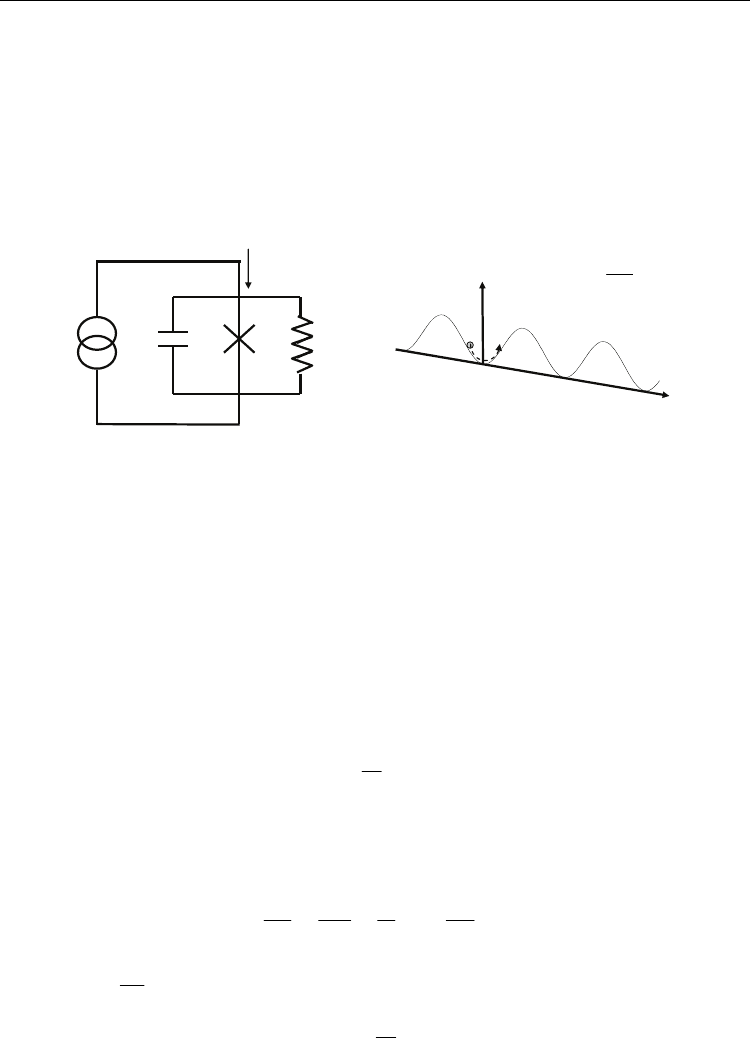
Superconductor
312
equation for phase to explore different regimes for phase dynamics.(Koval, Fistul et al. 2004)
In certain condition the phase demonstrates the mode locking of the internal and external
frequencies, namely the phenomenon of Shapiro steps. In section 3, we will focus on the
phase diffusive regime and begin with the phase correlation so as to derive the resulting
charge tunneling rate.(Liou, Kuo et al. 2008) In section 4, we briefly introduce the approach
by using the Bloch waves as the quantum sate basis. In section 5, the photon-assist
tunneling(Tucker & Feldman 1985) will be briefly addressed and in section 6, we review
some experiment works. Possible microwave detection application based on the above
phenomena will be discussed.
()
1cos
2
J
I
UE
e
φ
φ
=− −
φ
C
R
I
(a)
(b)
Fig. 1. (a) The model circuit of the resistively(R) and capacitively(C) shunted junction. (b)
The phase dynamics in a junction under a dc current bias can be modeled with a particle of a
mass C moving in a tilted washboard potential.
2. Langevin equation for superconducting phase
The celebrated resistively and capacitively shunted junction(RCSJ) is a classical way to
describe the phase dynamics from a circuit point of view(see Fig. 1(a)). In this model, a
model capacitance C and a model resistor R are connected in parallel to the junction under
consideration. We note that a Josephson junction obeys the so-called voltage-phase relation
and the current-phase relation that
2
sin
SC
V
e
II
φ
φ
=
=
in which I
C
is the junction critical current. Therefore, the phase
φ
obeys an equation of
motion as
(
)
sin
82 2 2
Q
C
C
R
It
I
ERe e
φφ φ
π
++ =
, (1)
in which
2
2
C
e
E
C
= is the charging energy, and I is the total bias current. The critical current is
related to Josephson energy E
J
through 2
J
C
E
Ie=
.
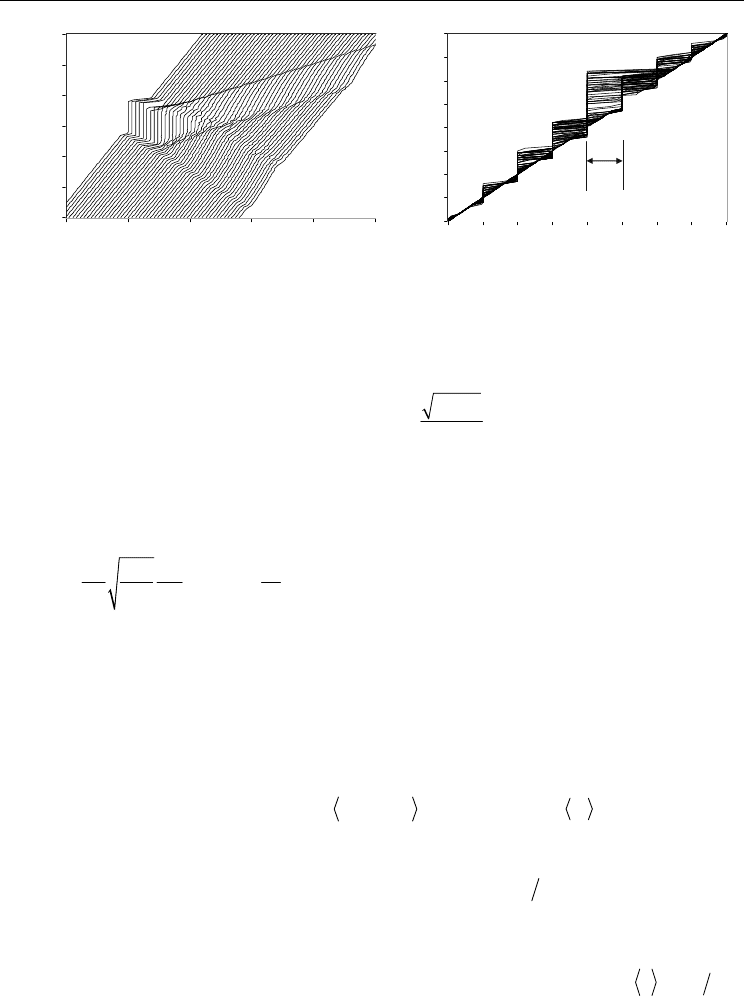
Phase Dynamics of Superconducting Junctions
under Microwave Excitation in Phase Diffusive Regime
313
60
-60
-40
-20
0
20
40
20
0
-50 0 50 100 150
40
-40
-30
-20
-10
0
10
20
30
40-40 -30 -20 -10 0 10 20 30
V (in unit of e/C)
ω
=0.01/2CR
Q
ω
=10/2CR
Q
ΔV
V (in unit of e/C)
I (in unit of e/CR
Q
)
I (in unit of e/CR
Q
)
(a)
(b)
Fig. 2. The calculated current-voltage(IV) characteristics of an RC-shunted junction under the
ac current driving of various amplitudes at a low frequency(a) and a high frequency(b). Note
that the curves in (a) are shifted for clarity. With high frequency driving, the junction exhibits a
mode-locking for superconducting phase at certain voltages with an equal spacing ∆V=ω/2e.
A dimensionless time scale,
p
t
τ
ω
= , in which
8
CJ
p
EE
ω
=
is the plasma frequency, can be
introduced further in such a way to yield a reduced equation, namely
(
)
sin f
φ
αφ φ τ
++ =
. (2)
Here
2
2
2
Q
C
J
R
E
ER
α
π
=
and
C
I
f
I
= is the bias current in unit of I
C
. It can be clearly seen that
expression (2) is of the form of Langevin equation describing a particle in a washboard
potential as depicted in Fig. 1(b) with dimensionless dissipation
α
and a (dimensionless)
driving force f. Also it resembles the dynamics of a damped simple pendulum, in which
φ
describes the angle of the pendulum to the vertical direction. When this system is kept in
equilibrium with a heat bath, the heat bath provides thermal fluctuations which can be
modeled as random forces to the system. In this sense, the right-hand side of the equation
should be written as
(
)
f
ξ
τ
+
, in which
(
)
ξ
τ
describes the random force and should obeys
the fluctuation-dissipation theorem that
(
)
(
)
0
B
kT
ξ
τξ α
=
in which denotes ensemble
average.
When the junction is excited by the microwaves, an external force periodic in time will be
exerted to the particle, namely,
(
)
01
sinfff
τ
ωτ
=+
. Here
p
ω
ωω
=
is the dimensionless
microwave frequency. By inputting all ingredients, one can solve equation (2) to get a
distribution of particle in phase space
(
)
,
φ
φ
. The results can be compared to those from
current-voltage (IV) measurement by calculating the average particle velocity
2
p
veV
φ
ω
==
as a function of f
0
at various ac forces and dissipations. Intuitively speaking, when the junction
when the junction is dc biased, it undergoes a periodic motion like the vertical circular motion

Superconductor
314
of a pendulum with an intrinsic angular frequency of v
φ
=
. Whenever there is an ac
driving of which the frequency matches the intrinsic frequency, the junction exhibits
interesting mode-locking phenomenon in such a way that the junction voltage is locked to
the resonant condition. It turns out the mode-locking can occur at
2
n
Vn e
ω
=
, producing
step structures in IV curves equally spaced in the voltage, called the Shapiro steps (see Fig. 2).
The above phenomenon is analyzed in a naïve way without dissipation consideration. Kovel
et al (Koval, Fistul et al. 2004) explicitly derived the result without ac driving (
1
0f =
)
analytically in the diffusive regime and found that at small voltage ranges,
0
22
C
S
I
v
I
v
α
δ
=
+
in which
δ
quantifies the diffusion of the phase by
(
)
(
)
(
)
cos 0 exp
φ
τφ δτ
⎡−⎤= −
⎣⎦
. One can
clear see that the dissipation gives rise to a finite voltage drop even in the “coherent”
Cooper-pair tunneling branch. The supercurrent would be peaked at
v
δ
=
, which can be
verified by experiments.
With the presence of the ac driving, the current can be expressed by the summation of
incoherent multi-photon absorption and emissions:
()
20 20
11
2
SnS nS
nn
ff
I J Ivn J IVn
e
ω
ω
αω αω
∞∞
=−∞ =−∞
⎛⎞ ⎛⎞
⎛⎞
=−= −
⎜⎟
⎜⎟ ⎜⎟
⎝⎠
⎝⎠ ⎝⎠
∑∑
(3)
Here
J
n
(x) denotes the Bessel functions. We note that this result is similar to that derived by
Tien and Gordon (Tien & Gordon 1963) for the single charge tunneling.
3. Spectral function theory
The incoherent Cooper-pair tunneling can be analyzed by the theory of spectral function
P
(E), in which the tunneling rate can be expressed by
2
() ()
2
J
EEPE
π
Γ=
, (4)
from which the net supercurrent can be obtained
(
)
[
]
2(2)(2)
s
IV e eV eV=Γ −Γ− (Schon &
Zaikin 1990). The spectral function is given by the Fourier transform of the correlation
function(Devoret, Esteve et al. 1990; Ingold & Nazarov 1991)
() ( )
0
/
1
()
2
it i
iEt
PE e e e dt
ϕϕ
π
∞
−
−∞
=
∫
.
In thermal equilibrium, the phase fluctuation is Gaussian so the Wick’s theorem yields
() ( )
()
-0
exp
it i
ee Kt
φφ
= , in which
[
]
() () (0) (0)Kt t
ϕϕϕ
=− . Applying the fluctuation-
dissipation theorem, one can express K(t) by using the environment impedance Z(
ω
) in unit
of
Q
R [10]:
()
Re
1
() 2
1
B
it
kT
Q
Z
de
Kt
R
e
ω
ω
ω
ω
ω
∞
−
−
−∞
−
=
−
∫
. (5)

Phase Dynamics of Superconducting Junctions
under Microwave Excitation in Phase Diffusive Regime
315
In the case of an Ohmic dissipation, K(t) follows a square law in a short time scale. Whereas
it linearly decreases with time
(
)
(
)
()
QB
Kt RR kT t
π
=− beyond the RC time
()
1
RC
RC
τ
−
and inverse of Matsubara frequency
12
MB
kT
ν
π
=
, in which R and C are respectively the
environmental impedance and capacitance. Here we can refer to the phase-diffusion result
in previous section that
(
)
(
)
QB
p
RR kT
δ
πω
. Also the RC time can be viewed as a mean-
free time for the phase motion. One can see that this effect results in a finite resistance
around zero-bias either in thermal fluctuation regime,
B
p
kT
ω
or in quantum fluctuation
regime
Q
RR>≈ .
0100200
0.00
0.02
0.04
R=1kΩ
R=2.2MΩ
T=50mK
P(E) (1/μeV)
E (μeV)
10
-18
10
-14
10
-10
10
-6
10
-2
10
-14
10
-10
10
-6
10
-2
10
2
10
6
10
10
-K(t) (a. u.)
t (a. u.)
2
()
K
tt
∝
()Kt t
∝
1tRC∼
(a)
(b)
Fig. 3. (a)
K(t) function for an RC-shunted junction. When
1tRC
, it follows a square law,
describing a free particle moving under a constant driving force. In the long time limit, the
particle moves in a diffusive way so as to yield a correlation function linear in time. (b)The
calculated
P(E) function for R<R
Q
(black) and R>R
Q
(red). For R<R
Q
, the function is peaked at
E=0 while for R>R
Q
, the peak will be at E=E
C
, signify a Coulomb-blockaded charge
tunneling. Adopted from (Kuo, Wu et al. 2006)
In order to find the microwave influence to the supercurrent via the correlation function, we
turn to the classical equation of motion of superconduting phase under an ac driving force
by applying the model of a tilted-washboard potential. When the ac-bias frequency is much
smaller than the plasma frequency, the system is in the linear response regime. It can be
shown that the correlation function should have the following form,
0
() () ()
ac
Kt K t K t
=
+ , in
which
0
()Ktis the correlation function in absence of microwave while ()
ac
Kt represents the
contribution due to ac-driving under different initial conditions. Since the superconducting
phase obeys an equation of motion of
2eV
ϕ
=
, for the ac-driving part, the phase would in
general have a sinusoidal motion with an amplitude of
2
ac
xeV
ω
=
and a frequency the
same as the ac-driving one. Substitute the result into the correlation function, we have
() ( ) () ( ) ()
00
00coscosit i i t i ix t ix
ee e e e
ϕϕ ϕ ϕ ωθ θ
θ
−−+−
,
in which
θ
is the initial phase constant, and
(
)
0
t
ϕ
is the part of high frequency fluctuations.
The latter average on the right-hand side is taken on the initial condition,
θ
. Now the P(E)
reads
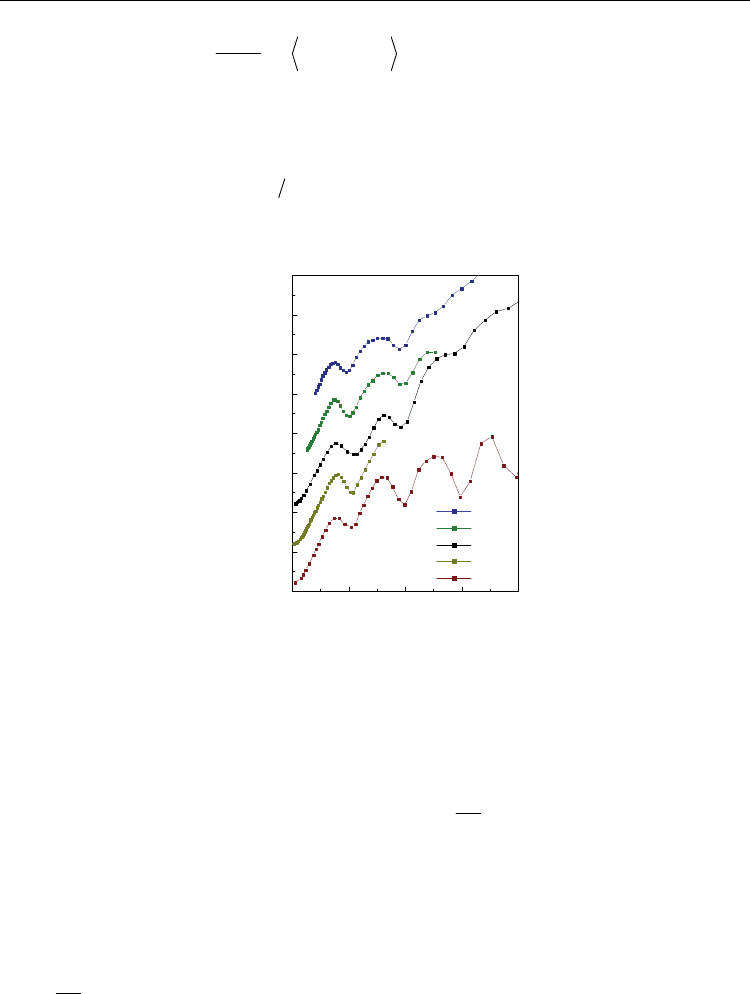
Superconductor
316
() ( ) ()
()
00
0cos
cos /
0
2
0
1
() lim
2
()
T
it i ix tt
ix t iEt
T
n
n
PE e e e e e dtdt
T
JxPEn
ϕϕ ω
ω
π
ω
∞
′
−+
′
−
→∞
−∞
∞
=−∞
′
=
=−
∫∫
∑
(6)
Here
P
0
(E) is the spectral function in absence of the microwave influence, and satisfies the
detailed balance
(
)
00
()exp ()
B
PE EkTPE−= − , a consequence of thermal equilibrium. We
note that equation (6) is an expression of multiple photon absorption and emission with the
amplitude of Bessel function
J
n
(x).
01234
0.00
0.05
0.10
0.15
0.20
0.25
0.30
0.35
0.40
2.14G
1.90G
1.60G
0.94G
0.60G
R
0
(MΩ)
RF amplitude (arbitrary unit)
Fig. 4. The zero-bias resistance as a function of irradiating microwave (or RF) amplitude at
various frequencies. Here the resistances are shifted and the microwave amplitude is
rescaled to its period for each curve. The oscillation period is related to the superconducting
gap of the electrodes. Adopted from (Liou, Kuo et al. 2008)
Expression (6) gives a supercurrent
() ()
20
2
sns
n
IV J xI V n
e
ω
∞
=−∞
⎛⎞
=−
⎜⎟
⎝⎠
∑
. (7)
Here
0
()
s
IV is the Cooper-pair tunneling current in absence of the microwaves. When the
environmental impedance is much smaller than the quantum resistance, the spectral
function becomes Delta-function so as to yield a coherent supercurrent,
C
I at zero bias
voltage. In turn, the microwave-induced supercurrent becomes
(
)
(
)
2
sn Cn
IV IJ x= at a voltage
2
n
Vn
e
ω
=
, leading to the structure of Shapiro steps. Ideally, each step in IV curves
represents a constant-voltage state, labeled by
n, featuring a “coherent” charge tunneling
generated by the mode-locking. When the bias voltage is ramped, the junction would switch
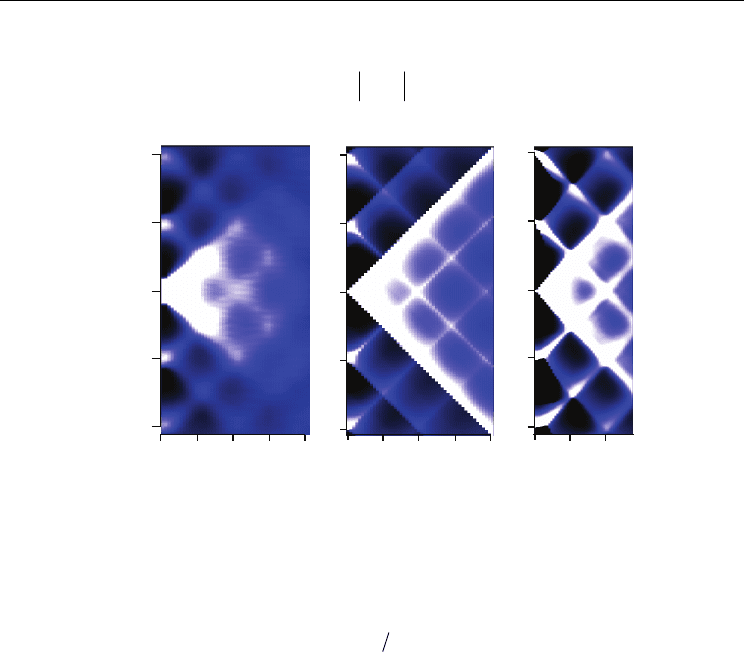
Phase Dynamics of Superconducting Junctions
under Microwave Excitation in Phase Diffusive Regime
317
from one constant-voltage state to another, and eventually jumps to the finite-voltage state.
It is noteworthy that in the analogy of a driven pendulum described in the previous section,
the mode-locking should yield
()
()
sn Cn
IV IJ x=
, a different result from the incoherent
square dependence.
Dc Voltage (eV
dc
/2Δ)
0.0
1.0
2.0
0.5
1.5
RF amplitude (eV
ac
/2Δ)
0.0
1.0
2.0
0.5
1.5
2.0
-2.0
0.0
1.0
-1.0
2.0
-2.0
0.0
1.0
-1.0
0.0
1.0
0.5
2.0
-2.0
0.0
1.0
-1.0
(a)
(b)
(c)
Fig. 5. The intensity plots of the dynamical conductance as a function of dc bias voltage
V
dc
and microwave amplitude
V
ac
of a long array(a) and a short array(c). According to the
model described in text, the conductance peaks evolve into a “mesh” structure with the
same period in
V
dc
and in V
ac
of 2Δ/e. Adopted from(Liou, Kuo et al. 2008)
When the microwave frequency
ω
is small, argument x and n large, the summation over n
can be replaced by an integration of
(
)
1
cosunx
−
= :
2
10
0
(2 ) ( cos )d
ssdcac
IIVVuu
π
π
−
=+
∫
. (8)
This expression is quite simple: It follows the same result as in the classical detector model.
We note that Eq. (8) gives a general description for mesoscopic charge tunneling processes
and should be applicable to both Cooper-pair tunneling and quasiparticle tunneling in the
superconductive junction system.
4. Bloch wave formalism
Previous results are classical in nature. In a quantum point of view, the phase is not a
function of time, but time-evolving quantum states. The un-biased single junction
Hamiltonian can be expressed by
2
0
4cos
CJ
HEnE
φ
=− . (9)
Here
n is the charge number, obeying the commutation relation
[
]
,ni
φ
=
. Because the
potential is periodic in
φ
, the wavefunctions have the form of Bloch waves in lattices:
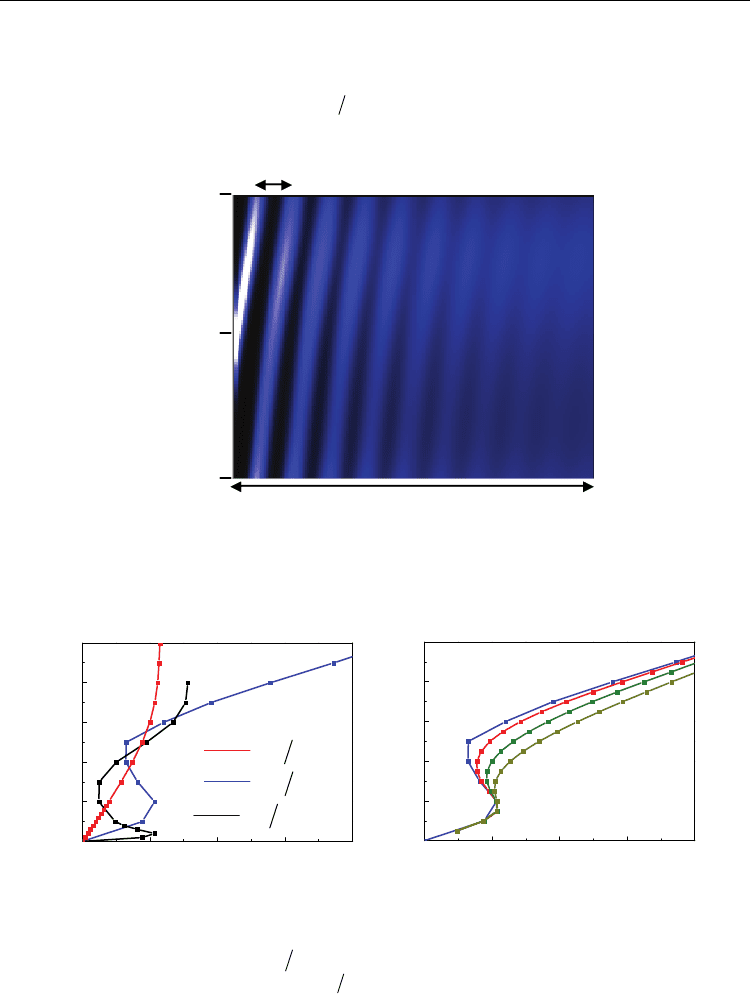
Superconductor
318
(
)
(
)
,
ik
ks
ue
φ
φφ
Ψ=
In which
()
,ks
u
φ
is the envelope function for lattice momentum k and band index s. When
there is a bias, an interaction term
(
)
2
I
HeI
φ
=
is added to the Hamiltonian, rendering the
change of the lattice momentum and inter-band transitions.
2RC time
quasi -charge
0.0
0.5
-0.5
Δ
t=e/I
Fig. 6. The calculated diagonal elements of the single band density matrix for the junction
under a dc-current bias. The expectation value of the lattice momentum (also called quasi-
charge) linearly increases in time. This results in an oscillatory response with a period in
time of
e/I.
0.00.51.01.52.0
0
1
2
3
4
5
Current
Voltage
0.00.51.01.52.0
0
1
2
3
4
5
Current
Voltage
1
Q
RR
=
0.2
Q
RR=
5
Q
RR
=
(a)
(b)
Fig. 7. (a) The calculated current-voltage characteristics of a junction with different
dissipation strengths using the Bloch wave formalism. A Coulomb gap appears when the
dissipation which quantified as
Q
RRis weak, featuring a relative stable quasi-charge.
When the bias current is larger than
x
IeRC= , the quasi-charge starts to oscillate, turning
the
IV curve to a back-bending structure. (b) The IV curves of a R=R
Q
junction under the ac
driving of various amplitudes,
I
1
. In both figures the voltage is presented in unit of e/C
while the current is presented in unit of
e/R
Q
C.

Phase Dynamics of Superconducting Junctions
under Microwave Excitation in Phase Diffusive Regime
319
It has been shown that in quantum dissipative system, the effect of environment can be
introduced through a random bias and an effective damping to the system.(Weiss 2008)
These effects would be better considered by using the concept of density matrix,
ρ
in stead
of wavefunctions
(
)
φ
Ψ :
[]
,
i
H
t
ρ
ρ
∂
=
∂
.
Especially, when dropping the contributions from the off-diagonal elements, one can write
down the differential equations for the diagonal parts:
()
()()
{}
2
22
1
ZE ZE
ss s
B
ss ss ss s ss ss s
s
IkT
V
tekeRk
eR k
σσ σ
σ
σσ
′
′′′′
′
∂∂ ∂
∂
=− + + + −Γ+Γ +Γ+Γ
∂∂∂
∂
∑
(10)
Here
()
,skkss
k
σρ
=
denotes the diagonal element of the density matrix for quasi-momentum
k and band s. Also called master equation, expression (10) describes the time evolution of the
probability of state
,ks . The terms describe the effect of the external driving force, the
resistive force, the random force, and interband transitions due to Zener tunneling(
Z
ss
′
Γ -
terms) and energy relaxation(
E
ss
′
Γ
-terms). Also,
,
1
ks
s
E
V
ek
∂
=
∂
describes the dispersion relation
of the Bloch waves in band
s.
By calculate the time-evolution of the density matrix elements, one can obtain the
corresponding junction voltage
ss
s
VVdk
σ
=
∑
∫
under a driving current I, yielding a
comparison to the
IV measurement results(Watanabe & Haviland 2001; Corlevi, Guichard et
al. 2006). The most important feature of this approach is the Bloch oscillation under a
constant bias current,
22Ie
ω
π
=
as illustrated in Fig. 6. In the IV calculations, a Coulomb
gap appears when
1
Q
RR
<
, featuring a relative stable quasi-charge. When the bias current
is larger than
x
IeRC= , the driving force is large enough for the quasi-charge to oscillate.
The Bloch oscillation features a back-bending structure in the
IV curve which cannot be
explained by previous approaches(see Fig. 7 for calculation results and Fig. 8 for
experimental results).
When the junction is driven by the ac excitation, namely
(
)
01
cosIt I I t
ω
=+ , a mode-locking
phenomenon may be raised at specific dc current
22
n
Ine
ω
π
=
. This mode-locking can be
viewed as a counterpart of the Shapiro steps, which gives characteristic voltages
n
Vn eV
ω
= . The master equation approach, although more accurate than the classical
ways, involves complicate calculations so a numerical method is un-evitable.
5. Photon-assisted tunnelling
The method introduced in previous section is a perturbative approach which may not be
appropriate when the bias current is large. Alternatively, one may consider the eigen-energy
problem for a periodically driven system describe by the Hamiltonian:
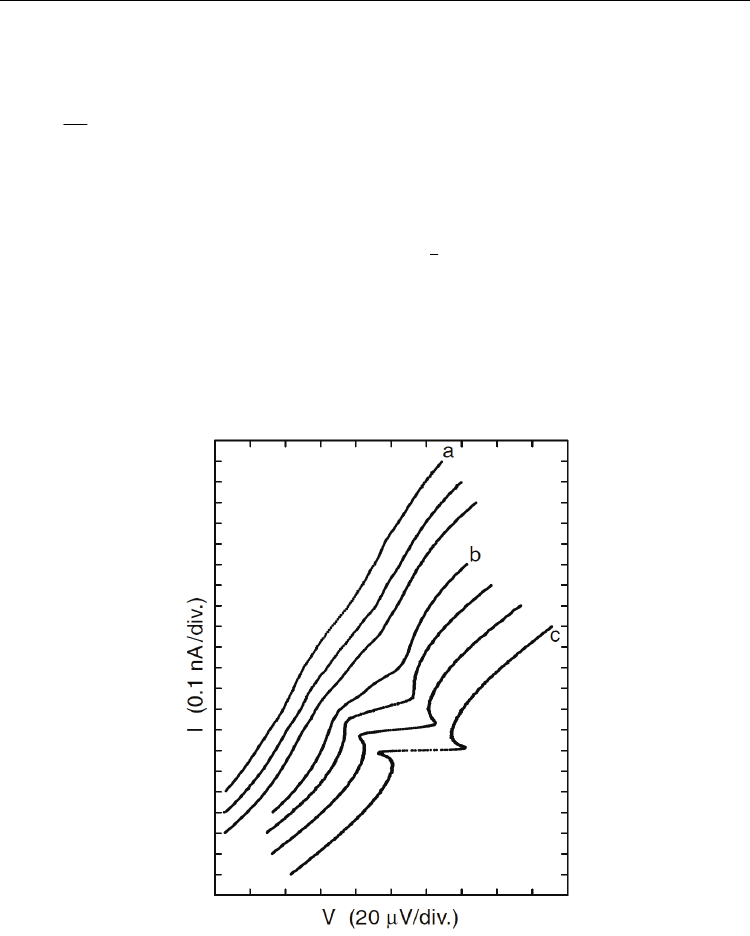
Superconductor
320
(
)
0 I
HH Ht=+ ,
in which
2
0
4cos
CJ
HEnE
φ
=−
, and H
I
is a periodic function with frequency
ω
, satisfying
()
,
2
in t
IIIn
n
Ht Ht He
ω
π
ω
⎛⎞
+= =
⎜⎟
⎝⎠
∑
. Here
,In
H is the n-th Fourier component in the frequency
domain.
In general, it can be solved by applying the Floquet’s theorem, which is similar to the Bloch
theorem, in the following way:
()
i
Et
in t
n
n
tee
ω
ψ
−
Ψ=
∑
. (11)
The result can be viewed as a main level at energy E with sideband levels spaced by
ω
. To
determine the coefficients
Ψ
n
, one needs to solve the eigen equation:
0,nImnmn
m
HH E
ψ
ψψ
+
+=
∑
.
Fig. 8. The
IV curves of the single junction in tunable environment of different impedances.
From top left to bottom right, the environment impedance increases. Origin of each curve is
offset for clarity. Adopted from (Watanabe & Haviland 2001)
Tien and Goldon (Tien & Gordon 1963) gave an simple model to describe the charge
tunneling in the presence of microwaves. Suppose the ac driven force produces an ac
